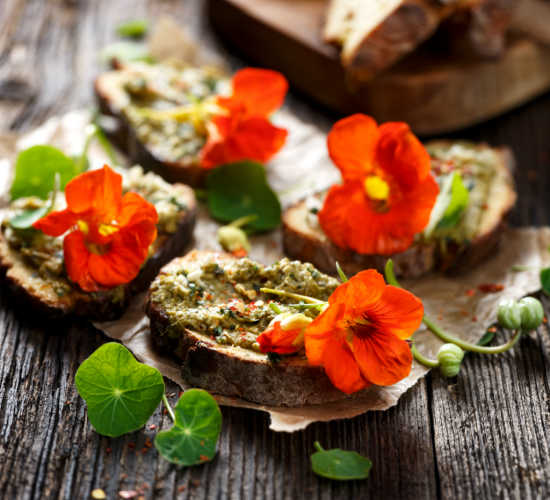Nasturtiums are a beautiful addition to your garden. Not only are they lovely to look at, but they are attractive to aphids and lure them away from your tender vegetables and melons, and they deter whiteflies and cucumber beetles. If you companion plants, place them near your broccoli, kale, cabbage, cauliflower, cucumbers, melons, squash, radishes, lettuce, and tomatoes. In addition, you could plant them where you would like to see hummingbirds because they love nasturtiums too.
Nasturtiums aren’t just for protecting your garden, did you know that they are edible? Nasturtium leaves, stems, and flowers have a peppery taste, which makes them the perfect addition to a summer salad. Also, they can be pickled and used in place of capers or processed into a zesty pesto. According to Dr. Axe, (Nasturtium Uses, Benefits, Recipes, How to Grow and More – Dr. Axe (draxe.com)) nasturtiums contain antioxidants and have a comparable amount of vitamin C to parsley. They also include “potassium, phosphorus, magnesium, calcium, manganese, copper, zinc, and iron.” Include these flowers in your summer garden planning, and then enjoy a delicious strawberry nasturtium salad, a summer potato salad with pickled nasturtiums, or a nasturtium pesto to a French baguette as an appetizer.
Related: Edible Flowers: 42 Varieties to Add to Your Garden
Strawberry Nasturtium Salad
Because nasturtiums have a slightly bitter taste, they pair well with the sweetness of strawberries; this salad is quick to assemble and full of summery flavor.
Ingredients
3 oz watercress
3 oz arugula
2 handfuls of nasturtium flowers and leaves, chopped
2 cups diced strawberries
1/8 cup poppy seeds
¼ cup sunflower seeds
Vinaigrette
1/8 cup sunflower oil
1/8 cup apple cider vinegar
1 tbs honey
1/4 tsp Himalayan sea salt
Directions
- Combine all salad ingredients together.
- Whisk all vinaigrette ingredients together and then add it to the salad.
- Serve immediately.
Pickled Nasturtium Seeds
Pickled Nasturtium seeds are the perfect replacement for capers; in fact, they are called the poor man’s capers. I may not always have access to capers, but I do have access to the nasturtium seeds that grow in my yard. Add these in place of capers to your favorite pasta dish, to a summer potato salad, or to deviled eggs.
Ingredients
- 2 cups freshly picked nasturtium seeds
- 2 cups white wine vinegar
- 2 tsp kosher salt
- ¼ onion thinly sliced
- 1 smashed garlic clove
- 1 crushed bay leaf
- 4 to 8 peppercorns (add more if you would like more spice)
Directions
- Pick a batch of nasturtium seeds from your garden.
- Place the nasturtium seeds inside a medium bowl and soak in water. Gently swirl the seeds in order to loosen any dirt that may be on them. If any stems or flower parts float to the surface, discard them.
- Place the nasturtium seeds into a one-pint sterilized mason jar with a few sprigs of fresh dill, sliced onion, smashed garlic, and crushed bay leaf.
- Bring the vinegar, salt, and pepper to a boil over medium-high heat, stirring consistently to dissolve the salt. Pour the brine mixture over the nasturtium seeds.
- Seal the mason jar and store the nasturtium seeds in a cool, dry place. Allow the seeds to pickle for two weeks, and then transfer to the refrigerator. Try to wait a few additional weeks before indulging.
- For long-term storage, place the sealed pint of nasturtiums in a boiling water bath for 10 minutes; this canning time may need to be adjusted for those who live at a high altitude.
Nasturtium Pesto
My family loves to use pesto, and it is a go-to for those of us on the Keto diet. Nasturtium leaves can be used in place of basil in pesto; they pack a delicious, radish-like punch.
Ingredients
- 50 nasturtium leaves, preferably large
- ½ cup sliced nasturtium stems
- ¼ cup pine nuts
- ½ cup olive oil
- ½ cup parmesan cheese
- 4 cloves garlic
- Salt and pepper to taste
Directions
- Wash the nasturtium leaves and set them aside.
- Bring a large pot of water to a boil and prepare an ice-water bath and set aside.
- Add the Nasturtium leaves to the boiling water and cook for about 10 – 12 seconds, but not longer.
- Transfer the nasturtium leaves to the ice water bath and let cool, and then drain the nasturtiums and place them on a paper towel.
- Toast the pine nuts by placing them in a dry pan over medium-high heat. Stir every 30 seconds for 2 to 3 minutes; this will intensify the flavor.
- Fill a food processor halfway with the nasturtium leaves and then blend until they are well-chopped. Continue until all the leaves have been used up.
- Add in the pine nuts and chop well.
- Add in the parmesan cheese and half of the oil and then pulse.
- Add more oil and pulse until the desired consistency is achieved.
- Add salt, black pepper, more nuts, or cheese, and continue to pulse until it tastes the way you would like.
These are just a few recipes detailing how to use nasturtiums, but there are many more to try. Bon appetite!
Additional Reading:
Here’s the Absolute Best Way to Tell If a Wild Plant is Edible
The Incredible Edible Dandelion: Using This Weed to the Fullest
4 Healthy Reasons Why Echinacea is a Wondrous Medicinal Herb
This article was originally published at Ready Nutrition™ on June 21st, 2021







